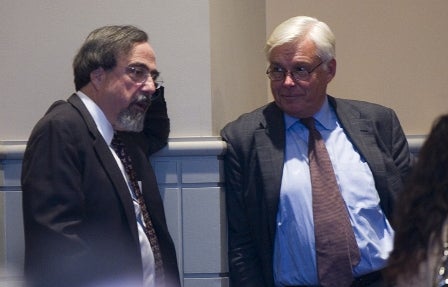Developers: cautious optimism, cost concerns

Ed Hille photo / Michael Sklaroff and Craig Schelter
Nov. 15
By Matt Blanchard
For PlanPhilly
Amid the clapping of hands for the PennPraxis waterfront plan on Wednesday night, one group of attendees was biting their nails.
Developers and land owners – on whose property all the magic is supposed to happen – reacted to the Praxis plan with a range of emotions: from a doubtful “glass half-empty” attitude to a sense that the glass might be full, and should be raised for a cautious toast.
On the toasting side was developer Bart Blatstein, a late addition to the evening’s panel discussion, who said the plan was “a marriage of the development community, the planners, and most importantly, the community.”
“Kudos to Harris Steinberg and everyone involved,” Blatstein said.
Yet on the most contentious feature of the plan, the extension of the city’s street grid over large parcels of privately-owned land, Blatstein was less sunny:
“The development community would be nervous,” he said. Property owners should be nervous.”
Breaking up existing mega-parcels with a grid of public streets is intended to spread Philadelphia’s cozy character right to the water’s edge. It’s also meant to prevent a certain Atlantic City-style of development that could erect a wall-of-towers along the river.
“William Penn gave us the grid. We still walk these streets, we still feel safe on these streets,” Praxis director Harris Steinberg told the crowd. The grid, he said, goes back to a “deeper psychological idea of who we are as a city.” For developers, he said, it should provide “a framework for growth that is really infinite.”
Not so fast, argues Craig Schelter, a former director of the city planning commission now consulting major riverfront land owner Jim Anderson.
“Harris said what clearly this audience wanted to hear, but nobody here wanted to ask the next questions,” Schelter said. “ I think maybe 10 percent of this land is publically owned. The rest is private. Start plotting streets on here – you’ve got to have an acquisition strategy, and I haven’t seen one.”
Someone has to build these streets, Schelter argues. Ask the city to do it and you’re generating huge expenses. Ask developers to do it, and waterfront projects will become prohibitively expensive.
“You can load up a project with public costs until you can’t finance it anymore,” Schelter said. “You’ll kill development and that sends a terrible message.”
Another plan critic, Ballard Spahr real estate attorney Michael Sklaroff, declined to comment, as did landowner Jim Anderson, who controls the former Pinnacle casino site (Cramps Shipyard) and holds long term leases for several other sites.
Will developers fight the plan? Will they get behind it? It’s too soon to be sure.
But two men who bridge the traditional community-developer divide sounded notes of optimism.
Center City District head Paul Levy, a pragmatic voice on the planning group’s steering committee, said a chilly response from developers can be overcome.
“For developers, this city has been about uncertainty,” Levy said. “So the very legitimate first reaction from any developer is ‘One more hurdle? One more requirement? You’ve got to be kidding.’”
The answer, Levy said, is to quickly establish a quasi-public agency to create the public spaces and infrastructure called for in the plan.
“Whether it’s a quasi-public, non-profit or city entity, the key is for every developer to know who they’re negotiating with and what the rules are,” Levy said. “There needs to be an entity with the authority to implement those deals.”
And it may be, Levy said, that certain projects are so far down the line toward construction that it might be “unfair or unlawful” to stop them now.
A second bridge between builders and planners is Councilman Frank DiCicco. An original supporter of the plan, he assured the crowd that developers are starting to see the waterfront requires truly urban design, with lively streetscape and pedestrian scale.
“Having dealt with developers for years, more recently most developers are recognizing the need for projects to be more than a residential high rise,” DiCicco said. “There has to be a connection to the street level.”
“In my discussions with developers over the last two years, I think they get it,” he said. “I think they get it.”
Matt Blanchard is a former Philadelphia Inquirer reporter. Contact him at blanchard.matt@gmail.com
WHYY is your source for fact-based, in-depth journalism and information. As a nonprofit organization, we rely on financial support from readers like you. Please give today.






